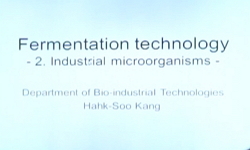Capsaicinoids in red pepper powder are known to show anti-bacterial effects; however, their effects during kimchi fermentation are not known. This study aimed to investigate the effects of various concentrations of capsaicinoids on kimchi fermentation...
http://chineseinput.net/에서 pinyin(병음)방식으로 중국어를 변환할 수 있습니다.
변환된 중국어를 복사하여 사용하시면 됩니다.
- 中文 을 입력하시려면 zhongwen을 입력하시고 space를누르시면됩니다.
- 北京 을 입력하시려면 beijing을 입력하시고 space를 누르시면 됩니다.



Influence of Capsaicinoids Content on the Microbial Community during Kimchi Fermentation = Influence of Capsaicinoids Content on the Microbial Community during Kimchi Fermentation
한글로보기https://www.riss.kr/link?id=A106435672
- 저자
- 발행기관
- 학술지명
- 권호사항
-
발행연도
2019
-
작성언어
-
- 주제어
-
등재정보
KCI등재,SCIE,SCOPUS
-
자료형태
학술저널
-
수록면
1580-1590(11쪽)
- DOI식별코드
- 제공처
- 소장기관
-
0
상세조회 -
0
다운로드
부가정보
다국어 초록 (Multilingual Abstract)
Capsaicinoids in red pepper powder are known to show anti-bacterial effects; however, their effects during kimchi fermentation are not known. This study aimed to investigate the effects of various concentrations of capsaicinoids on kimchi fermentation. Five sets of kimchi samples were prepared using 0 mg/kg (control), 98.34 ± 5.34 mg/kg (mild), 243.47 ± 3.71 mg/kg (medium), 428.63 ± 30.78 mg/kg (hot), and 1,320.49 ± 28.27 mg/kg (extreme) capsaicinoid. The characteristics of each kimchi sample, including pH, acidity, organic acid, sugars, sugar alcohol, capsaicinoid content, and microbial community were periodically investigated during fermentation. Kimchi with red pepper powder shows significantly higher acidity than control kimchi, whereas pH values were the same. Organic acid in kimchi with red pepper powder was higher than in control kimchi, probably caused by higher lactic acid bacteria (LAB) counts in kimchi samples with red pepper powder. Our results show that addition of red pepper powder decreased Leuconostoc spp. counts in the bacterial community. In particular, Lactobacillus sakei and Leuconostoc gelidum counts increased and decreased, respectively, with increasing capsaicinoid content of red pepper powder added to kimchi. Overall, the results of this study indicate that physicochemical properties and LAB such as L. sakei and L. gelidum are influenced by capsaicinoid content. However, further studies are necessary to investigate the effects of the percentage of red pepper powder in kimchi on fermentation to provide practical guidelines for producing standardized kimchi.
동일학술지(권/호) 다른 논문
-
- 한국미생물생명공학회(구 한국산업미생물학회)
- ( Wenli Xu )
- 2019
- KCI등재,SCIE,SCOPUS
-
- 한국미생물생명공학회(구 한국산업미생물학회)
- ( Gabriela N. Tenea )
- 2019
- KCI등재,SCIE,SCOPUS
-
Effect of Lactobacillus Fermentation on the Anti-Inflammatory Potential of Turmeric
- 한국미생물생명공학회(구 한국산업미생물학회)
- ( Cheng Chung Yong )
- 2019
- KCI등재,SCIE,SCOPUS
-
- 한국미생물생명공학회(구 한국산업미생물학회)
- ( Yanjie Liu )
- 2019
- KCI등재,SCIE,SCOPUS





 ScienceON
ScienceON KISS
KISS





